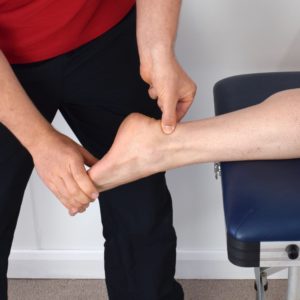Achilles tendinopathy (AT) is a common running related injury, reportedly affecting 9 – 11% of runners (Kujala et al, 2005). Pain in the Achilles can either be at the tendon-bone insertion (insertional AT) or a couple of centimeters up in the tendon (mid-portion AT). This blog post will focus on mid-portion AT. Further information on insertional AT can be found here .
The Achilles is the tendon that connects the calf muscles (soleus and gastrocnemius) to the heel bone (calcaneus). The Achilles tendon is the thickest and strongest tendon in the human body. It has to tolerate the highest forces exerted on the body, with the load being up to ten times a person’s body weight during running, jumping and hopping. Due to this significant load being exerted on the tendon, it is the most frequently injured tendon (Alrashidi et al, 2015).
What are the symptoms of Achilles tendinopathy
- Gradual onset of pain and tenderness over the mid-portion of the Achilles
- Stiffness over the Achilles upon waking and with activity following rest, which may last for a few minutes
- Swelling and a lump may develop over the tendon
- Pain and stiffness initially with activity, which may disappear after a few minutes, and then increased pain after the activity
What causes Achilles tendinopathy
Onset is more common in those in their 30’s and 40’s, with men affected more than women. Onset is normally due to an increase in load, when a person increases their training load or returns back to training after a period of inactivity. AT is a complex issue, but can be simply understood as an overuse condition of the tendon.
How to treat Achilles tendinopathy
The first goal of rehab is to reduce pain through activity modification by avoiding any aggravating activity. This will reduce the stress on the Achilles to a level that the tendon can manage, allowing the pain to settle. The next goal of rehab is to improve the tendon’s ability to handle load by starting an exercise program that will progressively load the muscle-tendon unit (Cook et al. 2018). Addressing biomechanical factors that may have contributed to increased load on the tendon may also be required. Recovery is normally slow and may require 12 weeks of progressive loading, followed by a graded return to running.
Research has shown that at five years following conservative treatment, only 65% of patients have recovered and are symptom free. AT can be complicated to treat, with a subset of patients not responding to standard conservative treatment. If you think you have AT, please call us on (02) 9232 5566 or click here to schedule a consultation with one of our Bend + Mend Sports Physios in Sydney’s CBD.
References:
Alrashidi Y, Alrabai HM, Alsayed H, Valderrabano V. Achilles tendon in Sport. Sports Orthopaedics and Traumatology. 2015;31(4):282-292






